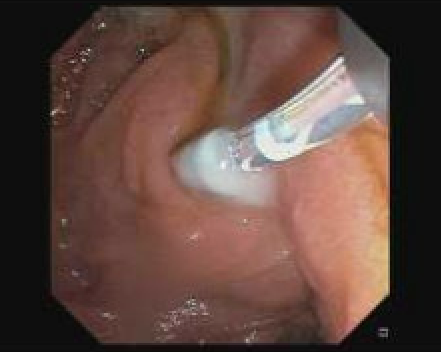Sunday Poster Session
Category: Biliary/Pancreas
P0227 - Management of Acute Obstructive Suppurative Pancreatic Ductitis: A Rare Clinical Entity With Serious Implications
Sunday, October 26, 2025
3:30 PM - 7:00 PM PDT
Location: Exhibit Hall

Rachel E. Garrity, MD (she/her/hers)
Emory University School of Medicine
Atlanta, GA
Presenting Author(s)
Rachel Garrity, MD1, Devika Gandhi, MD2, Field Willingham, MD, MPH1
1Emory University School of Medicine, Atlanta, GA; 2Emory University, Cleveland, OH
Introduction: Acute obstructive suppurative pancreatic ductitis (AOSPD) can be defined as purulent drainage from the pancreatic duct, leading to infection. While rare, it is important to distinguish it from cholangitis, other pancreatic pathologies, and other causes of sepsis. Here, we present the case of sepsis due to AOSPD managed endoscopically.
Case Description/
Methods: We present the case of a 54-year-old female with a history of spontaneous splenic rupture status post splenectomy and recurrent acute on chronic pancreatitis with multiple outside ERCPs, who presented with one day of nausea, vomiting, inability to tolerate PO intake, and abdominal pain. She became febrile during admission to 101.3F. On physical examination, she had mild epigastric tenderness. Her lab work revealed a leukocytosis of 34.3, lactic acid of 1.7, AST of 20, ALT of 22, ALP of 132, a total bilirubin of 0.6, and a lipase of 1149. She underwent CT abdomen pelvis with IV contrast that showed a dilated pancreatic duct with multiple calcified stones within the pancreatic duct and intraparenchymal pancreatic calcifications. An ERCP was performed with cannulation of the ventral pancreatic duct. Pancreatography revealed a diffusely dilatated pancreatic duct to 20 mm with intraductal stones. Balloon sweeps of the ventral pancreatic duct yielded white stone debris and purulent material. A 7 Fr x 12 cm pancreatic duct stent was placed which continued to drain purulent material. Given the endoscopic findings a diagnosis of acute obstructive suppurative pancreatic ductitis was made. Her symptoms and sepsis improved promptly, and she was discharged from the hospital with antibiotics to finish a ten-day course. She was planned for a repeat ERCP in six weeks for pancreatoscopy and lithotripsy with stent exchange.
Discussion: The differential diagnosis for a patient with a history of chronic pancreatitis who presents with fever and abdominal pain is broad. While acute-on-chronic pancreatitis and cholangitis are more common diagnoses, it is important to consider AOSPD as a cause of abdominal pain and sepsis. Awareness of the entity of AOSPD can help expedite appropriate interventions which can greatly impact the outcome for patients.

Figure: Purulent pancreatic duct drainage after cannulation.

Figure: Balloon occlusion ventral pancreatogram.
Disclosures:
Rachel Garrity indicated no relevant financial relationships.
Devika Gandhi indicated no relevant financial relationships.
Field Willingham indicated no relevant financial relationships.
Rachel Garrity, MD1, Devika Gandhi, MD2, Field Willingham, MD, MPH1. P0227 - Management of Acute Obstructive Suppurative Pancreatic Ductitis: A Rare Clinical Entity With Serious Implications, ACG 2025 Annual Scientific Meeting Abstracts. Phoenix, AZ: American College of Gastroenterology.
1Emory University School of Medicine, Atlanta, GA; 2Emory University, Cleveland, OH
Introduction: Acute obstructive suppurative pancreatic ductitis (AOSPD) can be defined as purulent drainage from the pancreatic duct, leading to infection. While rare, it is important to distinguish it from cholangitis, other pancreatic pathologies, and other causes of sepsis. Here, we present the case of sepsis due to AOSPD managed endoscopically.
Case Description/
Methods: We present the case of a 54-year-old female with a history of spontaneous splenic rupture status post splenectomy and recurrent acute on chronic pancreatitis with multiple outside ERCPs, who presented with one day of nausea, vomiting, inability to tolerate PO intake, and abdominal pain. She became febrile during admission to 101.3F. On physical examination, she had mild epigastric tenderness. Her lab work revealed a leukocytosis of 34.3, lactic acid of 1.7, AST of 20, ALT of 22, ALP of 132, a total bilirubin of 0.6, and a lipase of 1149. She underwent CT abdomen pelvis with IV contrast that showed a dilated pancreatic duct with multiple calcified stones within the pancreatic duct and intraparenchymal pancreatic calcifications. An ERCP was performed with cannulation of the ventral pancreatic duct. Pancreatography revealed a diffusely dilatated pancreatic duct to 20 mm with intraductal stones. Balloon sweeps of the ventral pancreatic duct yielded white stone debris and purulent material. A 7 Fr x 12 cm pancreatic duct stent was placed which continued to drain purulent material. Given the endoscopic findings a diagnosis of acute obstructive suppurative pancreatic ductitis was made. Her symptoms and sepsis improved promptly, and she was discharged from the hospital with antibiotics to finish a ten-day course. She was planned for a repeat ERCP in six weeks for pancreatoscopy and lithotripsy with stent exchange.
Discussion: The differential diagnosis for a patient with a history of chronic pancreatitis who presents with fever and abdominal pain is broad. While acute-on-chronic pancreatitis and cholangitis are more common diagnoses, it is important to consider AOSPD as a cause of abdominal pain and sepsis. Awareness of the entity of AOSPD can help expedite appropriate interventions which can greatly impact the outcome for patients.

Figure: Purulent pancreatic duct drainage after cannulation.

Figure: Balloon occlusion ventral pancreatogram.
Disclosures:
Rachel Garrity indicated no relevant financial relationships.
Devika Gandhi indicated no relevant financial relationships.
Field Willingham indicated no relevant financial relationships.
Rachel Garrity, MD1, Devika Gandhi, MD2, Field Willingham, MD, MPH1. P0227 - Management of Acute Obstructive Suppurative Pancreatic Ductitis: A Rare Clinical Entity With Serious Implications, ACG 2025 Annual Scientific Meeting Abstracts. Phoenix, AZ: American College of Gastroenterology.

